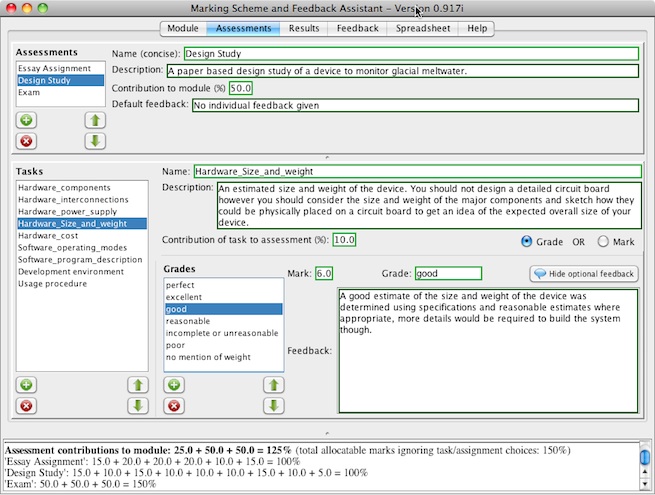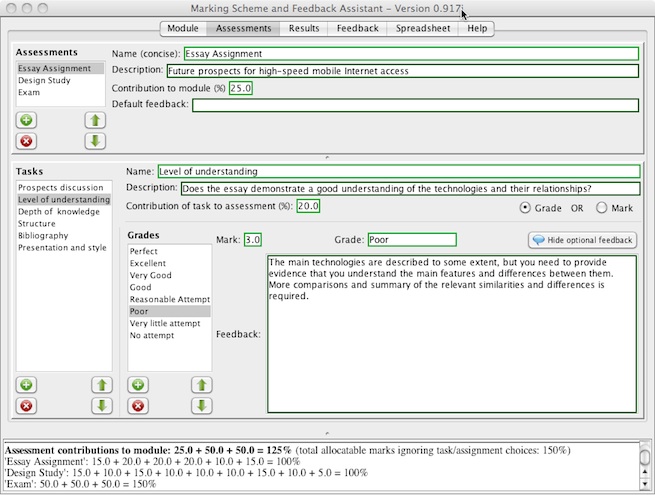This page discusses the choice of grades for an assignment task.
Grades example - design study
The MFA allows any number of grades for task. Use a concise name for each grade in the list, and a general description of how the grade could be improved in the feedback areas. If there is the potential for a number of improvements of different natures, then leave these for the additional feedback list for the task. That way the various possible improvements can me 'mixed and matched' as required for each student, with whatever level of hedging is required.
The maximum mark available for a task will provide 100% of the specified task contribution to the assignment (10% in the example below). All task contributions for an assignment should normally sum to 100%, as seen in the lower information panel on when the Module page is selected. Lower marks provide a correspondingly lower contribition. Any range of marks can be used for a specific task, so assuming 5 grades (plus zero) the available marks could be 0, 1, 2, 3, 4, 5 or for example 0, 2, 5, 7.5, 9, 10 if required. For these cases the students will see x/5 or x/10 in their report for the task. Generally, it helps to not have too fine grained set of grades to avoid agonising between them. The tool will use the mark associated with the top grade to determine what the maximum mark available is, and therefore it makes sense to have a grade "perfect" even if you never intend to give 100% (why? - if I can't think of a single improvement why is it not 100%). Occasionally what was done might be perfect, but the problem or scope undertaken/selected was not challenging enough.

The grade levels may well be related to the deliverable aspects in an abstract sense, for example, "all aspects of the task were completed to a high standard", "Most aspects of this task were well done, but a few could be improved", "Most of the aspects of this task could be improved", "Very little attempt made for some aspects of this task" etc." Clearly, words like task can be replaced with more specific terms, e.g. "Design", "Program Code", "Algorithm", "Functional requirement" "Introduction", "Bill of Materials", "Performance analysis", etc. It is possible to assign the same mark to several grade entries; "generally good" and "very good in places, incomplete" might be used to indicate the difference between a student that had addressed all the issues, with arguments that could be improved, and a student that missed some issues, but perhaps made a better job of the remainder. Don't try and think of these in advance, simply add grades during marking when it becomes clear that there is a need, because the grade comment is not appropriate. Often bespoke comments are a better way of explaining these difficult cases.
Grades example - essay
The following example is a marking scheme for simple short essay style report. In this case many of the tasks are fairly generic for this type of assignment, although the detailed feedback is more talored to the specific question -technologies and future prospects. Often the feedback text can be pasted from one grade to another and modified to suit, moving between positive confirmation of the achievements, to indications of improvement areas for lower grades. Very high grades may make reference to minor polishing. Very poor grades need more general advice as to what need to be done - the details of improvements for higher grades may be rather irrelevant at that level.
